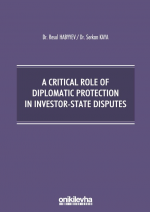 In the new global world of trade, there is an increase in the number of international investments. The continuously increasing international investments raises the probability of international disputes arising between investors and host states. This book aims at discussing current and future roles of diplomatic protection as the main international dispute settlement mechanisms for investor-state disputes.(ARKA KAPAKTAN)
In the new global world of trade, there is an increase in the number of international investments. The continuously increasing international investments raises the probability of international disputes arising between investors and host states. This book aims at discussing current and future roles of diplomatic protection as the main international dispute settlement mechanisms for investor-state disputes.(ARKA KAPAKTAN)
TABLE OF CONTENT
CHAPTER ONE
INTRODUCTION
1.1. Introduction
1.2. The Structure of Book
CHAPTER TWO
THE CUSTOMARY INTERNATIONAL LAW AND INDIVIDUAL'S PROTECTION
2.1. Introduction
2.2. A Historical Assessment of the Protection of Aliens: Diplomatic Protection
2.3. The Calvo Doctrine (1868)
2.4. The Hull Formula (1938)
2.5. International Law Commission [ILC] Draft Articles on the Responsibility of States for Internationally Wrongful Acts (2001)
2.6. International Law Commission's Draft Articles on the Expulsion of Aliens (2014)
2.7. The International Law Commission [ILC] Draft Articles on Diplomatic Protection, 2006
2.8. The Necessity of Diplomatic Protection
CHAPTER THREE
THE EXERCISING DIPLOMATIC PROTECTION AND ICSID CONVENTION
3.1. Introduction
3.2. Conditions for Exercising Diplomatic Protection
3.3. The Nationality of Individuals in International Law
3.4. Nationality and Diplomatic Protection
3.5. The Nationality of Companies and Diplomatic Protection
3.6. Diplomatic Protection: Stateless Persons and Refugees
3.7. Nationality under the ICSID Convention
3.8. Shareholders Rights
CHAPTER FOUR
THE EXHAUSTION OF LOCAL REMEDIES
4.1. Introduction
4.2. The Exhaustion of Local Remedies under Customary International Law
4.3. The Exhaustion of Local Remedies in Investment Treaty Arbitration
CHAPTER FIVE
THE COLLAPSE OF DP AND THE PROMISE OF THE ICSID CONVENTION
5.1. Introduction
5.2. The Political Character of the ICSID Convention: Diplomats v. Arbitrators
5.3. The Functions of the Home State and the Host State in Investor-State Arbitration
5.4. The Political Aspects of Investment Arbitration for Developing Countries
5.5. The Political Aspects of Investment Arbitration for Developed Countries
5.6. Does the ICSID Convention Only Stand Up for Developed Countries?
5.7. Withdrawing from the ICSID Convention
5.8. The Union of South American Nations (UNASUR)
CHAPTER SIX
ENFORCEMENT MECHANISMS USED IN INVESTOR-STATE DISPUTES
6.1. Introduction
6.2. The Power of the ICSID When Granting a Stay of Enforcement
6.3. Enforcement Against the Assets of State-Owned Enterprises (SOEs)
6.4. Diplomatic Protection in the ICSID Convention: Article 27
6.5. The Different Opportunities Investors have to Enforce Investment Awards against States
6.6. State to State Arbitration
6.7. The Recognition and Enforcement of Awards under the New York Convention of 1958
CHAPTER SEVEN
RESOLUTION OF INVESTOR-STATE DISPUTES IN THE AGE OF CORONAVIRUS: THE NEED FOR MOVING TO ONLINE DISPUTE RESOLUTION
7.1. Introduction
7.2. The Advent of Online Dispute Resolution
7.3. The Main Online Disputes Resolution Methods
7.4. Resolution of Investor-State Disputes through ODR
CHAPTER EIGHT
CONCLUSION AND RECOMMENDATIONS
8.1. Conclusion
8.2. Recommendations
BIBLIOGRAPHY
